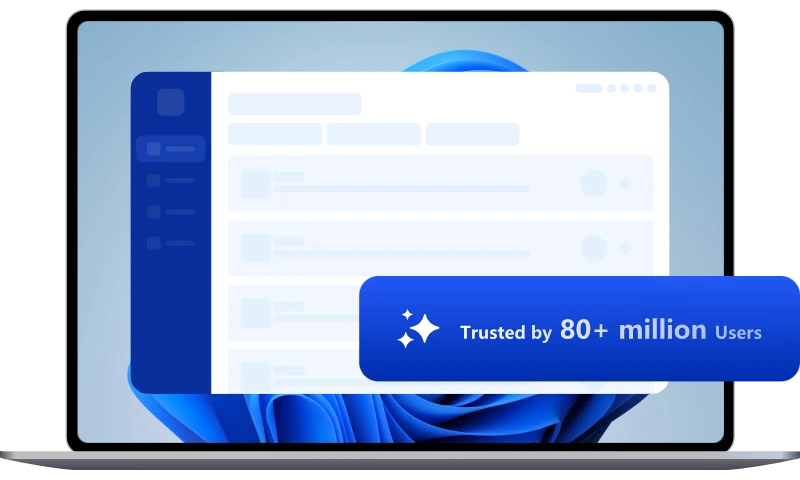Best Mirror Backup Software – What It Is & How It Works [FREE Download]
In this article, you’ll learn what the best mirror backup software is, how it works, and how to create a mirror backup in Windows 10 or 11. Scroll down to learn more!
What Is a Mirror Backup Software?
Mirror backup software creates an exact, real-time, or scheduled copy of your files from one location to another- often an internal or external drive, NAS, or network drive. Everything in the source folder is mirrored: add a file and it appears in the backup; delete a file and it’s removed from the backup as well. In sum, mirror backup software is designed for fast, efficient protection.
Here are 5 primary features below:
- No restore process required- for instant file recovery (without downtime), especially for creators or businesses.
- Fast performance - only changed data copies over
- Simple setup, often with real-time or scheduled syncing
- Perfect for urgent recovery when a drive fails or a file is accidentally deleted
- No file versions - deleted files may be lost
Mirror Backup vs Full Backup vs Sync
Besides mirror backup (or mirror sync), there are two other confusing concepts - full backup and sync. Here's a quick comparison table.
|
Type |
What It Does |
Pros |
Cons |
|
Mirror Backup/Sync |
Make an identical copy of selected folders |
Fast, easy, ready-to-use, even without restoring |
Deletion will be synced to mirrors unless protected. |
|
Full Backup (Image Backup) |
Create a compressed archive system or disk image |
Full recovery, protects OS + apps + data |
Larger space, slower, not instantly accessible |
|
File Sync |
Keep two folders in sync, usually bidirectional |
Ideal for collaboration |
Both sides change each other - risky as a backup |
The Best MirrorBackup Software for Windows (Top Pick)
AOMEI Backupper Professional is one of the best mirror backup software for Windows 10, 11, and previous systems, offering users 3 flexible options - Basic Sync, Real-Time Sync, and Mirror Sync.
💡Which one should you use?
🕐 For schedule mirrors, pick Basic Sync or Mirror Sync. Be sure to enable the option to sync deletions while using Basic Sync.
⏳ For Real-time mirrors, pick Real-Time Sync. It will immediately sync changes and deletions to destination.
🥇 For strict mirrors, pick Mirror Sync. It will delete files or folders you manually add to destination, whereas the other two modes will not.
In sum, mirror backup is essentially a 1:1 replica, whether it’s real-time or schedule sync. This software offers users 7 options, based on daily, weekly, monthly, or event triggers. Also, it fully supports local drives, external drives, network shares, NAS, or computers.
How to Create a Mirror Backup on Windows 10 Step by Step
Step 1. Download, install, and launch AOMEI Backupper Professional. Then, select Sync > Mirror Sync. You can also select Basic Sync or Real-Time Sync per your needs.
Step 2. Click Select Source/Add Source to select files or folders for mirroring. Then, click the PC icon to select a location to save them. It can be another local drive, an external disk, NAS, etc.
Step 3. Click Schedule Sync and enable it. You can then pick one based on daily, weekly, monthly, etc., or event triggers. Confirm and click Start Sync to create a mirror backup on Windows 10.
💡Note: You can click Options to comment on this mirror backup to distinguish it, or enable email notifications to get timely alerts.
Final Thoughts
Mirror backup software is one of the fastest ways to protect important data copy is always up-to-date and immediately accessible; you don’t need to restore anything- just open the mirrored drive and use it as if nothing happened.
For users who deal with large files, active projects, or prefer instant file recovery, mirror backup delivers simple, reliable protection. For safety, it’s suggested to create a full image backup as well. Download AOMEI Backupper to have a try!
FAQs
1. Will mirror backup slow down my PC?
Usually no. Most mirror backup software works quietly in the background and only copies changed files. Scheduled mirrors has virtually no impact, and even real-time mirroring only consumes system resources when files are modified.
Older PCs or HDD-based systems may feel a slight slow down during large transfers, but on modern SSDs or NAS drives, the performance impact is minimal.
2. Can I delete originals after mirroring?
You can, but it’s not recommended. A mirror backup is designed to track the source, so if you delete a file on the original drive, many mirror tools will delete it on the backup as well.
If you want to free space but keep this backup, store the files in a different folder or use an archive backup instead of a mirror.
3. Is mirror backup good for video/photo workflows?
Yes. Creators often use mirror backups because the copied files remain fully accessible- no restoring or extraction. You can edit videos or RAW photos directly from the mirrored drive.
Just remember: a mirror doesn’t store older versions, so if you overwrite or delete a project by accident, the change may sync to the backup too.
4. Can ransomware infect a mirrored backup?
Unfortunately, yes. Because the mirror matches the source, ransomware-encrypted files can overwrite the mirrored copies as soon as they sync.
For safety, it’s suggested to use scheduled mirrors instead of real-time, or pair mirror backup with image backup. You can also store offline backups on a disconnected drive.

